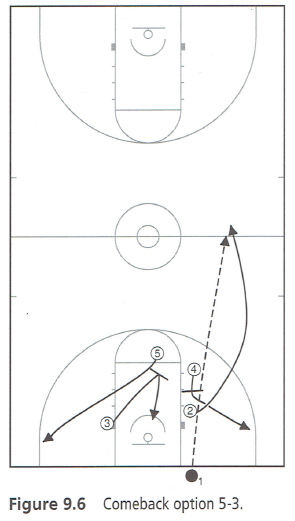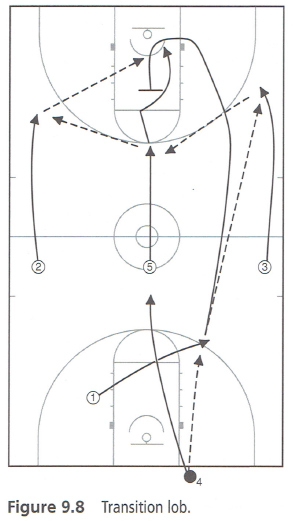|
3 Scoring Plays From the Backcourt By: Lee Rose Originally Published in Winning Basketball Fundamentals - Human Kinetics
Scoring off a play from the backcourt against pressure late in the fourth quarter is challenging. Specifically, getting the ball inbounds in this situation can be a problem for teams at all levels. To be successful, players who inbound the ball must be confident, must pass well, and must understand the rules, specifically when they can run the baseline and when they can only pivot but cannot take steps. They must also know that they cannot bounce the inbounds pass on the end line or sideline. Combine these necessary attributes with the fact that the inbounding player has only five seconds to get the ball inbounds, and this means that you need a player who is an accurate passer and has a cool head! Selecting the right person to inbound the ball in late-game situations should be done carefully and with great thought. Sometimes it is a good strategy to insert a backup point guard to inbound the ball and use the starting point guard as the inbounds receiver. The intent here is to keep the ball in the hands of reliable ball handlers. While reviewing our NBA roster at San Antonio for a possible trade, the name Ed Nealy came up for discussion. Nealy was a burly 6-foot-6 (198 cm) substitute who was on the bubble. But before anyone could say a word, Bob Bass, the Spurs' general manager, said, "He's a keeper because he is great at inbounding the ball." Nealy made a 12-year NBA career out of doing the little things well. Comeback Option 5-3 Focus Procedure 1. 01, on the end line, is the inbounds passer and lines up just outside the free-throw lane. 02 lines up about 10 to 12 feet (3 to 3.5 m) in front of 01, facing the opposite basket. 04 lines up 10 feet farther out on the court in a straight line with 01 and 02. 2. The major inbounds receivers, 05 and 03, line up on the middle of the free-throw line and on the weak-side low block, respectively. 3. As the referee hands the ball to 01, 04 sets a pin-down screen for 02. After a quick jab step inside to help 04 get a good screening angle on 02's defender, 02 breaks for the frontcourt. Only if 02 breaks open does 01 throw to him. After 04's down screen, he breaks to the strong-side corner, looking for the inbounds pass. 4. As soon as 05 sees 04 screen down for 02, 05 relocates to the corner of the free-throw line and 03 sets a back screen on 05's defender. 05 jab-steps and then breaks hard for the weak-side corner, looking for an inbounds pass from 01. After setting the screen, 03 cuts hard toward 01, looking for an inbounds pass. 5. 01 looks first for 02 and then for 04 in the right corner, 03 in the middle of the free-throw lane, and 05 sprinting to the weak-side corner (figure 9.6). Step-Out Bomb The step-out bomb play can be run only following a score when a team is permitted to run the baseline. Teams use the step-out bomb play when the defensive team is desperate and gambling all out to get the ball. This play is effective only when all five defenders are in a full-court man-to-man press. This timing play takes practice and a touch of deception to be effective. Only through practicing the play can the coach assign positions. The player who shoots the ball should have good speed and the passer must be skilled at throwing the long baseball pass. To illustrate in the following diagram, the players will be numbered, but when running this play in a game situation, specific skills determine player positions. Focus Procedure 1. The play begins just before the official hands the ball to 02. 05 fakes a screen for 03, but 03 ignores the screen and sprints out of bounds on the baseline, where he receives a pass from 02. 2. During this action, 01 fakes a screen for 04 and screens 02's defender on the baseline. 02 passes to 03 and immediately sprints off 01's screen, running down the sideline looking for the long pass from 03 (figure 9.7). 3. For inbounds options, 01 looks for the ball in the middle. 05 sets up at the top of the key and lets 04 run off him toward the sideline. 02 is the primary option. Transition Lob Teams that have good passers, jumpers, and players who make good decisions can run special lob plays off opponents' made free throws. The lob should be part of their transition offense, but they should not run it every time. They look to catch the defense unaware after time-outs or when new substitutes enter the game. The play can be extremely effective; defensive teams must be particularly alert to defend it properly. Focus Procedure 1. Play begins on a made free throw. 04 inbounds the ball quickly to 01, who is cutting across the free-throw lane. 04 then trails the play up the middle of the court. 2. 02 and 03 run the lanes, and 05 runs down the middle of the court. 3. 01 passes the ball ahead up the sideline to 03 at approximately the free-throw line extended. Following the pass, 01 sprints even to 03 and then dives to the low block strong side. 4. 05 sprints to the top of the key and receives a pass from 03. 05 then rotates the ball to 02, who is at the weak-side wing position. 5. While the ball is being rotated, 01 moves up the middle of the free-throw lane and sets a back screen on X5. On 05's pass to 02, 05 steps to the left to set up the defender and then swiftly runs off 01's screen, looking for the lob from 02 (figure 9.8).
|









